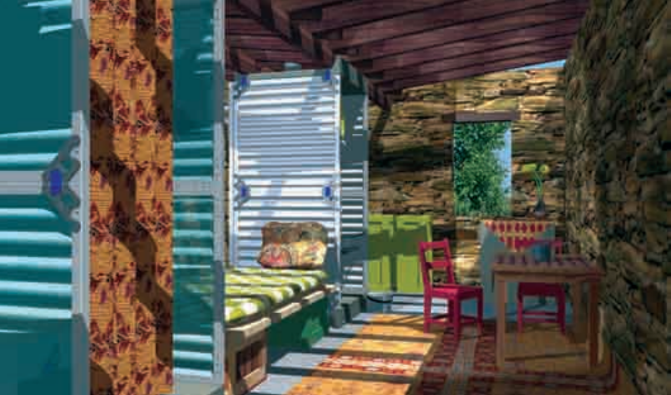

Rendering of core unit in relation to a ruined wall that will form part of the reconstituted house. Both images Gans and Jelacic
| Location | Philadelphia, Pennsylvania, USA (prototype for exhibition) |
| Date | 1999-present |
| Design Team | Deborah Gans, Matt Jelacic |
| Funding | Johnnie Walker “Keep Walking” Fund |
| Area | 24 sq. ft./2.2 sq. m |
The basic elements for life include access to water, sanitation, and shelter. All are encompassed in the Extreme Housing unit by Deborah Gans and Matt Jelacic.
The structure is a core system made of two freestanding boxes: One encloses a toilet, the other a hearth, internal cistern, and shower. Beams connect the two boxes, creating enough space for a bed. This easily assembled transitional structure can eventually become the core of a permanent structure or plug into a semidestroyed home. In a refugee situation the prefabricated core could be disassembled and transferred with the occupant back to a permanent dwelling.
Approximately 20 units fi t in a shipping container, and a team of four people using a wrench can assemble a unit in about six hours. Developed in response to the Architecture for Humanity 1999 Transitional Housing competition, the Extreme Housing unit was one of 10 finalists; it also won a $100,000 grant from the Johnnie Walker “Keep Walking” Fund.
The grant enabled the designers to refine their idea, primarily by traveling to the area and spending time with NGOs and relief experts. While the team received positive firsthand feedback from people in the field, the design needed a number of improvements, most dealing with cultural specificity. “There is always a great tension between the single universal solution and this cultural differentiation,” Gans notes.
Ease of assembly inspired the switch from an array of panels and parts to an unfolding unit. What emerged was a structurally stable three-sided configuration that could be built from a variety of materials in response to regional ecologies. The designers have since built different prototypes out of bamboo, cardboard, and microthin aluminum sheeting over a synthetic core.
“I count my biggest accomplishment to date as having helped lawyers, doctors, and aid workers to make the connection between good design and human dignity—dignity being a very important legal term in human rights law. ” Deborah Gans, designer















READ OR LEAVE A COMMENT